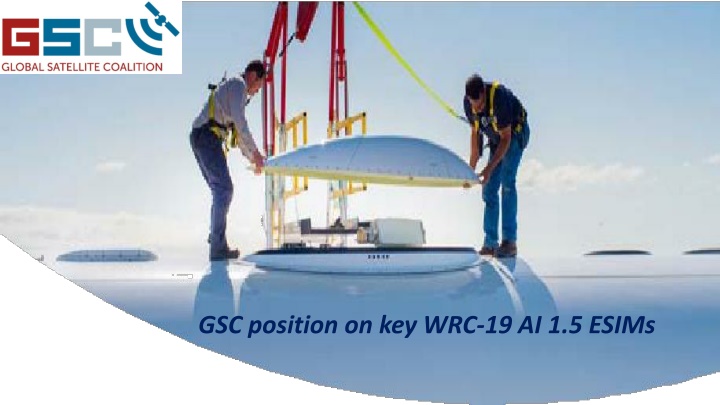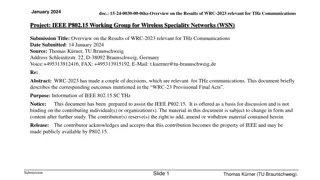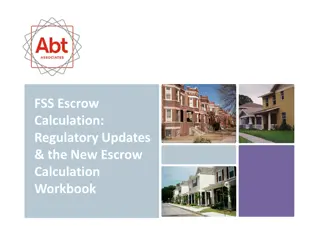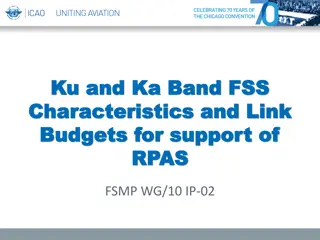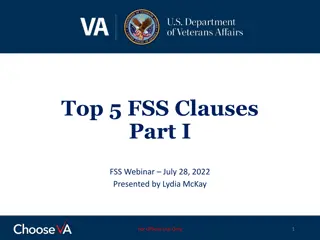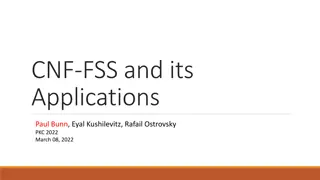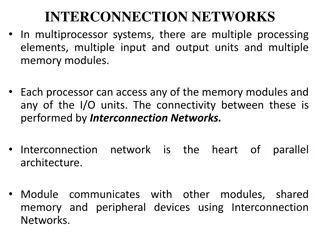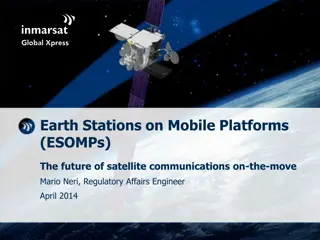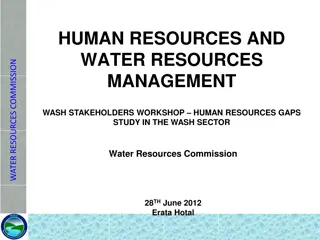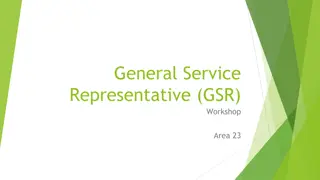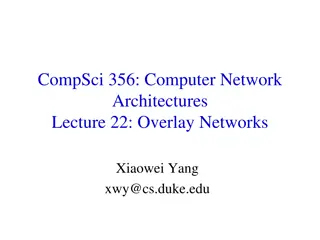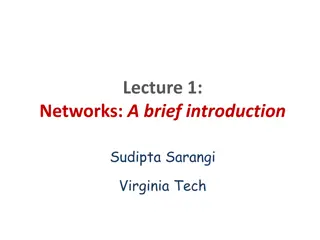ESIM Operations in GSO FSS Networks: WRC-19 AI 1.5
Addressing the growing demand for broadband satellite communications with mobility, WRC-19 AI 1.5 focuses on ESIM operations beyond specified frequency bands. It aims to facilitate ESIM operations in aeronautical, maritime, and land settings within GSO FSS networks, subject to technical and regulatory safeguards. The resolution builds upon WRC-15 provisions and seeks to harmonize ESIM operations with existing FSS allocations, emphasizing global broadband connectivity. An example modification to RR Appendix 4 is proposed, supported by a new WRC Resolution to guide ESIM operation conditions. Options for specific details have been discussed among involved parties.
Download Presentation

Please find below an Image/Link to download the presentation.
The content on the website is provided AS IS for your information and personal use only. It may not be sold, licensed, or shared on other websites without obtaining consent from the author.If you encounter any issues during the download, it is possible that the publisher has removed the file from their server.
You are allowed to download the files provided on this website for personal or commercial use, subject to the condition that they are used lawfully. All files are the property of their respective owners.
The content on the website is provided AS IS for your information and personal use only. It may not be sold, licensed, or shared on other websites without obtaining consent from the author.
E N D
Presentation Transcript
AI 1.5 ESIMs in the FSS Ka-band Goal: To facilitate the operation of ESIMs in GSO FSS networks in the Ka-band Genesis: Resolution 158 (WRC-15) Issue: to consider the use of the frequency bands 17.7-19.7 GHz (space-to-Earth) and 27.5-29.5 GHz (Earth-to-space) by earth stations in motion communicating with geostationary space stations in the fixed-satellite service and take appropriate action Background: WRC-15 adopted provisions for ESIM operations within the FSS allocation in the 19.7 20.2 GHz and 29.5 30 GHz bands subject to conditions in Resolution 156. Resolution 156 recognizes the need for global broadband mobile-satellite communications, and that some of this need could be met by allowing ESIMs to communicate with space stations of the fixed-satellite service (FSS) AI 1.5 of WRC-19 addresses operation of ESIMs beyond these bands to meet the increasing demand for broadband satellite communications with mobility Today many ESIMs are operating in the air, in the sea and on the land, and airlines in particular are seeking to provide gate-to-gate passenger connectivity. GSC General Position: Establish provisions for aeronautical, maritime, and land ESIM operations within GSO FSS networks in the Bands 17.7-19.7GHz and 27.5-29.5GHz, subject to technical and regulatory protection mechanisms for existing FSS operations & other allocated services. www.gscoalition.org
AI 1.5 ESIMs in the FSS Ka-band Background - Current status: Resolution 158 of WRC-15 resolves to invite the ITU-R to: 1. To study the technical and operational characteristics and user requirements of ESIM and the requirement for flexible use of spectrum to provide ESIM services; Further information in: Sections 2 & 3 of WP4A preliminary draft new Report ITU-R S.[AGENDA ITEM 1.5] & Reports ITU-R S.2223 & S.2357-0 2. To study sharing and compatibility between ESIM and current and planned stations of existing services allocated in the bands; Further information in: Section 4 of WP4A preliminary draft new Report ITU-R S.[AGENDA ITEM 1.5] as well as PDNRs S./M.[ESIM-MS], S./F.[ESIM-FS] and S.[ESIM] 3. To develop technical conditions and regulatory provisions for the three types of ESIMs operation (Land, Maritime, Aero) Based on text developed by WP 4A, the CPM Report includes an example Resolution for WRC-19, which includes the regulatory framework for ESIM operation as well as measures to ensure protection of other services. Most of the Resolution has been agreed at CPM, but there are some provisions for which the views of different administrations are indicated as options. www.gscoalition.org
Methods to satisfy AI 1.5 (WRC-19) Method A No change Method B This method proposes to add a new footnote No. 5.A15 in RR Article 5 and a reference to a new WRC Resolution providing the conditions for the operation of ESIM and protection of the services to which the frequency bands are allocated, and consequential suppression of Resolution 158 (WRC-15). An example modification to RR Appendix 4 called for by the new WRC Resolution is also included. The new Resolution to address Method B is agreed by all parties, but with options on some of the specific details
AI 1.5 ESIMs in the FSS Ka-band GSC Position technical conditions on ESIM operations (1) Support Method B to adopt a footnote in Article 5 and an associated Resolution that would define conditions for ESIM operations, including: that ESIMs communicate with FSS satellites and operate within the envelope of the FSS network that Maritime ESIMs that operate within 60-70 km distance of low water mark of a country are subject to the prior agreement of the concerned coastal State that Aero ESIM that does not meet the following PFD mask at the surface of the Earth are subject to the prior agreement of the concerned State. PFD( ) = -124.7 (dBW/m2/14 MHz) for 0 0.01 PFD( ) = -120.9+1.9 log10( ) (dBW/m2/14 MHz) for 0.01 0.3 PFD( ) = -116.2+11 log10( ) (dBW/m2/14 MHz) for 0.3 < 1 PFD( ) = -116.2+18 log10( ) (dBW/m2/14 MHz) for 1 < 2 PFD( ) = -117.9+23.7 log10( ) (dBW/m2/14 MHz) for 2 < 8 PFD( ) = -96.5 (dBW/m2/14 MHz) for 8 < 90.0 that ESIMs operating in 27.5-28.6 GHz band meet an off-axis EIRP mask outside 3 degrees of the GSO or a maximum ESIM transmit EIRP to protect NGSO FSS systems. If the ESIM cannot meet this off-axis EIRP mask, the maximum on-axis EIRP of 55 dBW for bandwidths up to 100 MHz should not be exceeded. For larger bandwidths, the on-axis EIRP may be increased proportionately www.gscoalition.org
AI 1.5 ESIMs in the FSS Ka-band GSC Position conditions on ESIM operations (2) The pfd mask is a hard limit protecting terrestrial services, where they are operating, which meets the requirement of Resolution 158. The pfd mask provides a level of certainty for operations of both ESIM and terrestrial services, and no further condition is necessary. An altitude limit is unnecessary, and is inherently in conflict with the ITU-R conclusion (WP 5A) that a pfd mask approach with multiple elevation angle limits is adequate to protect the mobile service. www.gscoalition.org
AI 1.5 ESIMs in the FSS Ka-band GSC Position responsibility for ESIM operations The administration under whose satellite network the ESIM is operating should ensure that the ESIM operator has the capabilities to respect the technical conditions as defined for ESIM operations. For Aero or Maritime ESIMs operating in international territories, and in the case of suspected or reported interference, the flagship administration should investigate the interference and identify the ESIM operator. The flagship administration should then work together with the administration under whose satellite network the ESIM is operating to take the actions required to remove the interference. Note: flagship means the country responsible for registering this aircraft or ship. www.gscoalition.org
AI 1.5 ESIMs in the FSS Ka-band GSC Position- on options in the example resolution in the CPM Report Resolution part Issue GSC position Resolves 1.1.4 Defining when ESIM can be associated with the existing GSO FSS network, i.e. only after recording the FSS network in the MIFR or during the CR/C stage Support Option 2, allowing submission of ESIM characteristics during the CR/C stage 1 Resolves 1.1.6 Whether limits for protection of NGSO FSS should be applied (27.5-28.6 or 27.5-29.1 GHz) Supports Option 1. No limits required in 28.6-29.1 GHz due the current coordination procedures. For the band 28.6-29.1 GHz, the current provisions of RR Nos. 9.12A and 9.13 together with resolves 1.1.1 of the draft new Resolution [A15] (WRC-19) provide enough assurance that ESIM would not cause interference to non-GSO FSS space station receivers. Support Option 2. No limits are necessary, interference issues are dealt with in the current coordination process Support View 1. Such a condition could lead to additional constraints on ESIM at any time in the future are therefore opposed. 2 Resolves 1.1.7 Whether limits are required to protect NGSO MSS feeder links 3 Resolves 1.2.2 and Resolves 1.2.3 Whether the provisions for protection of terrestrial services should include a requirement not to affect the future development of these services 4 Resolves 1.2.5 Whether the limits for protection of terrestrial services are deemed to ensure that unacceptable interference is not caused Support Option 3. Meeting the pfd and distances limits ensures that unacceptable interference is not caused. Proposals for additional conditions to avoid causing interference could lead to additional constraints on ESIM at any time in the future are therefore not supported. 5 Annex 2, para 2.1 The values for the pfd mask to protect terrestrial services from aero ESIM The Option 1 pfd mask provides adequate protection. The Option 2 mask overprotects terrestrial services and unnecessarily constrains aero-ESIM operations 6 Annex 2, para 2.2 The need for an altitude limit in addition to a pfd mask Support Option 2. There is no need for an altitude limit. The pfd mask provides all the protection necessary and an altitude limit would unnecessarily constrain aero-ESIM operations. 7 Annex 3 The need for Annex 3 Support deletion as the main body of the Resolution now covers the content of Annex 3. 8 www.gscoalition.org
Thank You www.gscoalition.org
